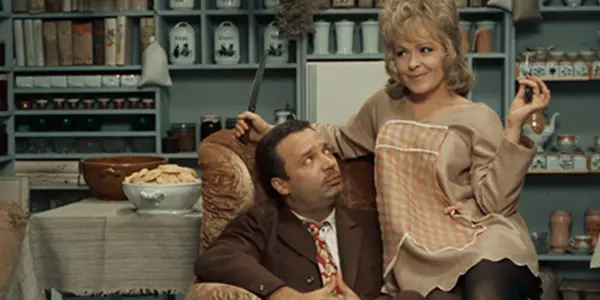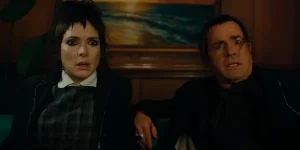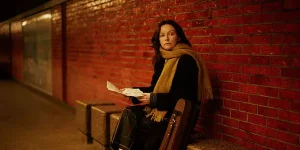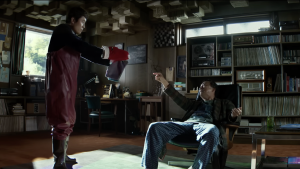
While Ester Krumbachová might not be a household name for many film lovers, she deserves to be. After all, the multitalented artist is responsible for infusing classics across the Czechoslovak New New Wave with the madcap energy and visual inventiveness that makes those films so memorable, including Jan Němec’s Diamonds of the Night (1964, costumer designer), Věra Chytilová’s Daisies (1966, writer and costume designer), and Jaromil Jireš’s Valerie and Her Week of Wonders (1970, writer and production designer), among many others. Alas, Krumbachová was only able to direct one film of her own before the Soviet takeover of Czechoslovakia effectively halted her cinematic career and forced her to find other outlets for her inestimable creativity, including handcrafted jewelry and painted postcards.
Fortunately for us, that film—Murdering the Devil, released in 1970—has been resurrected from obscurity in a beautiful new 4K restoration courtesy of Karlovy Vary International Film Festival in collaboration with Národní filmový archiv, Státní Fond Kinematografie at UPP, and Soundsquare Studios laboratories. Set for an exclusive one-week New York theatrical run at Metrograph as part of a series highlighting Krumbachová’s influence on the Czechoslovak New Wave, Murdering the Devil is a delightful feminist satire that renders an unholy battle of the sexes in incredible, eye-catching color. From the moment the playful opening credits—spelled out in colorful blocks—kick in to the tune of a woman crooning that she’d rather have the Abominable Snowman than no man at all, you know you’re in for a cinematic treat.
Living Deliciously?
Tired of the single life, a fortysomething bachelorette (Jirina Bohdalová) jumps at the chance to reignite her relationship with a man from her youth known as Mr. Devil (Vladimír Mensík). However, the charming, romantic, and slender man she reminisces about to the audience does not match the man who arrives at her door for dinner; arrogant, inelegant, and unshaven, his first words to her when she opens the door are “You’ve put on weight, and you aren’t so young anymore”—this despite the fact that she has put meticulous effort into her appearance. In contrast, his own shirt gapes open awkwardly over his midsection.
source: Arbelos
Nonetheless, our heroine is so desperate to settle down that she excuses Mr. Devil’s egregious behavior, including his insatiable hunger for the elaborate multi-course meals she prepares for him, his grotesque method of devouring every bite of food in her flat, and his incurable habit of abandoning her as soon as he’s finished eating. (Watching her prepare these meals will make your mouth water; watching him inhale them will make you never want to eat again.) Mr. Devil is so gluttonous that when plates break and food spills on the floor, he gobbles up not only the food, but the broken shards; he then compliments her by saying that her floor is clean enough to eat off of. Eventually, he ends up gnawing the legs off of all her furniture and chewing the giant plant that sprawls across her flat until its leaves crumble into dust.
source: Arbelos
In between sloppy, slobbering bites, Mr. Devil rambles on about his misunderstood genius, describes his supposedly unfair treatment at the hands of a younger and more beautiful lover, and name-drops Freud, Nietzsche, and Darwin in an attempt to sound smarter than he actually is. Meanwhile, our heroine feigns interest in his every word, batting her eyelashes and inviting him to mansplain endlessly in the hope that he’ll be so impressed by her capacity for listening that he’ll agree to marriage. However, she soon learns that Mr. Devil is no ordinary date from hell but an actual demon, intent on devouring everything she has while giving her nothing in return—no, not even a wedding ring.
Late Night with Mr. Devil
Murdering the Devil boasts one of the most aesthetically pleasing color palettes I’ve ever seen in a movie: a mix of cool teal blues, rich chocolatey browns, and warm peach tones. It’s basically the reversal of the red and green color scheme that one associates with traditional two-strip Technicolor, and as much as I love old films shot that way, I think Murdering the Devil is even more beautiful to look at—especially in this new restoration, which captures all of the rich color and texture one associates with mid-twentieth century film stock. The vast majority of the film takes place inside our heroine’s sprawling flat, a paradise of bright hues, ornate furniture, and overgrown plants; the cheerful teal kitchen is exactly what I would show to an interior designer if I had the space and the money to make it a reality. Indeed, it’s no wonder that the thing that sends our heroine over the edge is the destruction of her furniture at the mercy of Mr. Devil’s masticating jaws, because destroying any element of that space is an unforgivable crime against design.
source: Arbelos
In addition to writing and directing Murdering the Devil, Krumbachová also handled the costume design, dressing the female lead in sleek dresses and shimmering scarves and the male lead in sloppy suits that are barely held together at the seams. Despite being seemingly insecure about her advancing age and single status, Bohdalová oozes charm and sensuality that make watching her fawn over Mr. Devil all the more cringeworthy and absurd. Every time she finds herself boiling over with rage at his rudeness, she eventually talks herself into believing that he’s not that bad after all, her sharp voice softening into something sugary sweet. Even when he shows off his demonic powers by demolishing the elevator in her apartment building, her anger gradually dissolves into admiration at the masculinity on display in such destruction. While it’s equal parts amusing and infuriating to watch her make a fool out of herself this way, you can’t help but root for her to finally see the light and send Mr. Devil straight back to hell.
Meanwhile, Mensík is downright hilarious as the personification of misogynistic misbehavior, someone who sees the seductive woman who wants him as no more than a “little cook wench” who only requires “bonbons and a bit of flattery” to be wooed. At the same time, when he utters such nasty pronouncements, you can’t exactly accuse him of being wrong. After all, plenty of women out there are convinced that they’re happy to be “little cook wenches” for their husbands, and to wait on them hand and foot in return for little more than a pat on the head and a box of cheap chocolate. Those men aren’t even devils in disguise, just ordinary specimens who’ve convinced themselves that they’re worthy of extraordinary devotion for no other reason than that they are men. In allowing Mr. Devil to say these things so bluntly, Murdering the Devil tries to make women see that they deserve better—that they shouldn’t grovel at the feet of the first mediocre man who comes along just for the sake of no longer being alone.
Conclusion
A potent mix of sharp comedy and stunning visuals—not to mention, a jazzy lounge music score that only adds to the film’s energetic atmosphere—Murdering the Devil is a prime example of how exhilarating the films of the Czechoslovak New Wave can be, and how much they owe to Krumbachová’s myriad talents.
The new 4K restoration of Murdering the Devil begins an exclusive one-week New York theatrical run at Metrograph as part of The Phantom of Ester Krumbachová.
Does content like this matter to you?
Become a Member and support film journalism. Unlock access to all of Film Inquiry`s great articles. Join a community of like-minded readers who are passionate about cinema – get access to our private members Network, give back to independent filmmakers, and more.









